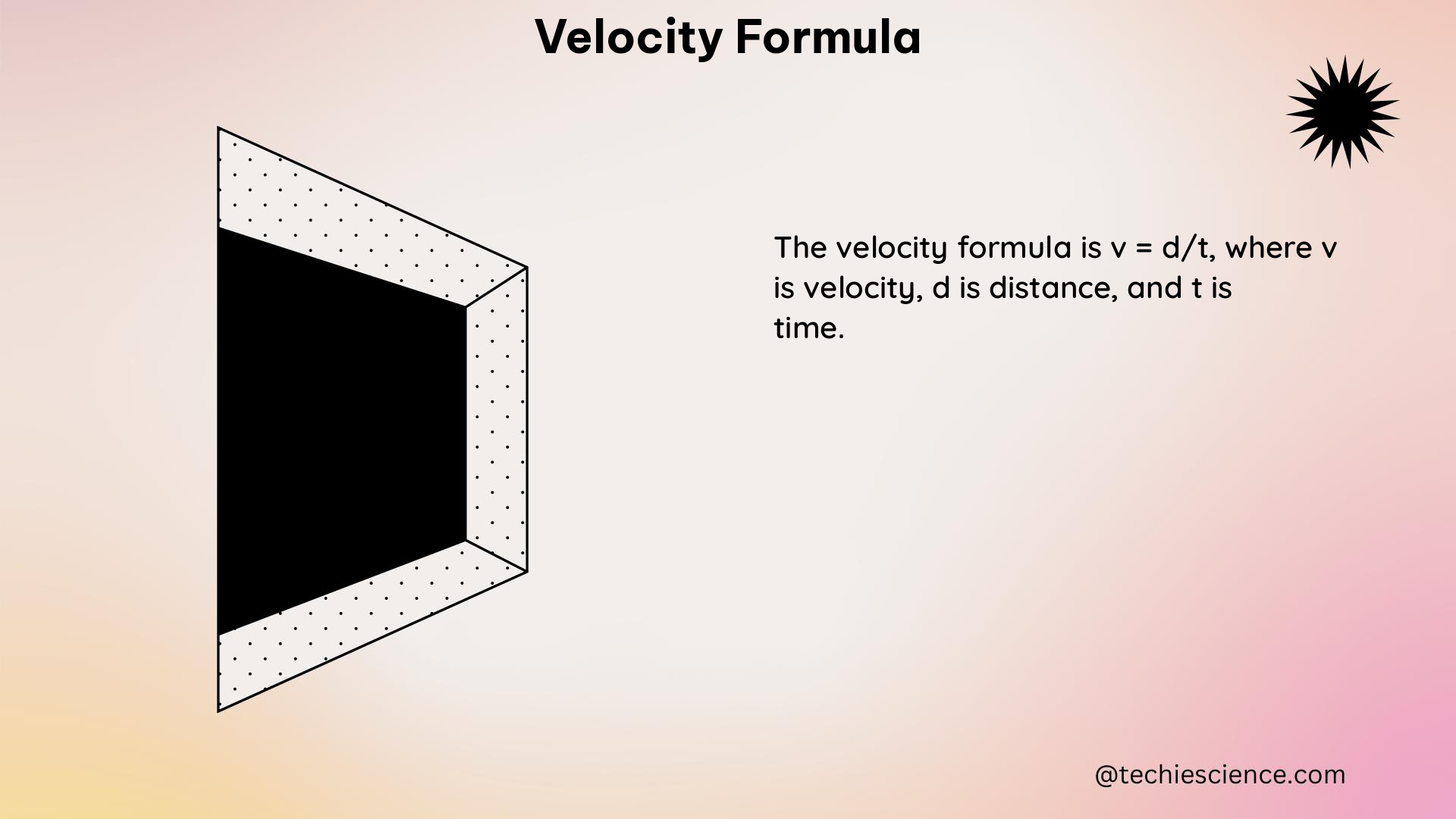The velocity formula is a fundamental concept in physics that measures the rate of change of an object’s position with respect to time. This comprehensive guide will provide you with a deep understanding of the velocity formula, its applications, and practical examples to help you master this essential topic.
Definition and Formula
Velocity is defined as the rate of travel of an object, including its direction. It is calculated using the formula:
$v = \frac{\Delta x}{\Delta t}$
where:
– $v$ is the velocity (in meters per second, m/s)
– $\Delta x$ is the change in position (in meters, m)
– $\Delta t$ is the change in time (in seconds, s)
Theoretical Foundations

The velocity formula is derived from the basic principles of kinematics, which is the study of motion without considering the forces that cause the motion. The formula is based on the relationship between an object’s displacement, time, and the rate of change of its position.
Displacement and Time
Displacement, denoted as $\Delta x$, represents the change in an object’s position over a given time interval. It is the difference between the object’s final position and its initial position.
Time, denoted as $\Delta t$, is the duration over which the object’s displacement occurs.
Rate of Change
The velocity formula, $v = \frac{\Delta x}{\Delta t}$, expresses the rate of change of an object’s position with respect to time. This rate of change is the average velocity of the object over the given time interval.
Applications and Examples
The velocity formula has a wide range of applications in various fields of physics, including mechanics, electromagnetism, and astrophysics. Let’s explore some practical examples to illustrate its use.
Example 1: Constant Velocity
Suppose a car travels a distance of 100 meters in 5 seconds. To find the car’s velocity, we can use the velocity formula:
$v = \frac{\Delta x}{\Delta t} = \frac{100 \text{ m}}{5 \text{ s}} = 20 \text{ m/s}$
This means the car’s velocity is 20 meters per second.
Example 2: Variable Velocity
Now, let’s consider a scenario where an object’s velocity changes over time. Suppose a ball is thrown upward and reaches a maximum height of 50 meters in 2 seconds.
To find the ball’s velocity at different points, we can use the velocity formula:
- At the start (t = 0 s): $v_0 = \frac{\Delta x_0}{\Delta t_0} = \frac{0 \text{ m}}{0 \text{ s}} = 0 \text{ m/s}$
- At the maximum height (t = 2 s): $v_2 = \frac{\Delta x_2}{\Delta t_2} = \frac{50 \text{ m}}{2 \text{ s}} = 25 \text{ m/s}$
- At the return to the starting point (t = 4 s): $v_4 = \frac{\Delta x_4}{\Delta t_4} = \frac{0 \text{ m}}{4 \text{ s}} = 0 \text{ m/s}$
This example demonstrates how the velocity formula can be used to calculate the velocity at different points during an object’s motion.
Numerical Problems
To further solidify your understanding of the velocity formula, let’s solve some numerical problems.
Problem 1
A car travels a distance of 120 meters in 10 seconds. Calculate the car’s velocity.
Solution:
$v = \frac{\Delta x}{\Delta t} = \frac{120 \text{ m}}{10 \text{ s}} = 12 \text{ m/s}$
Problem 2
A runner covers a distance of 800 meters in 2 minutes. What is the runner’s velocity in meters per second and kilometers per hour?
Solution:
$\Delta t = 2 \text{ minutes} = 120 \text{ seconds}$
$\Delta x = 800 \text{ meters}$
Velocity in meters per second:
$v = \frac{\Delta x}{\Delta t} = \frac{800 \text{ m}}{120 \text{ s}} = 6.67 \text{ m/s}$
Velocity in kilometers per hour:
$v = \frac{6.67 \text{ m/s} \times 3600 \text{ s/h}}{1000 \text{ m/km}} = 24 \text{ km/h}$
Key Takeaways
- The velocity formula, $v = \frac{\Delta x}{\Delta t}$, is a fundamental equation in physics that relates an object’s displacement, time, and the rate of change of its position.
- Velocity includes both the magnitude (speed) and the direction of an object’s motion, unlike speed, which only considers the magnitude.
- The velocity formula can be applied to both constant and variable velocity scenarios, allowing you to calculate the velocity at different points during an object’s motion.
- Mastering the velocity formula is crucial for understanding and solving a wide range of physics problems, from kinematics to electromagnetism and astrophysics.
References
- Serway, R. A., & Jewett, J. W. (2018). Physics for Scientists and Engineers with Modern Physics (10th ed.). Cengage Learning.
- Halliday, D., Resnick, R., & Walker, J. (2013). Fundamentals of Physics (10th ed.). Wiley.
- Young, H. D., & Freedman, R. A. (2016). University Physics with Modern Physics (14th ed.). Pearson.

The lambdageeks.com Core SME Team is a group of experienced subject matter experts from diverse scientific and technical fields including Physics, Chemistry, Technology,Electronics & Electrical Engineering, Automotive, Mechanical Engineering. Our team collaborates to create high-quality, well-researched articles on a wide range of science and technology topics for the lambdageeks.com website.
All Our Senior SME are having more than 7 Years of experience in the respective fields . They are either Working Industry Professionals or assocaited With different Universities. Refer Our Authors Page to get to know About our Core SMEs.